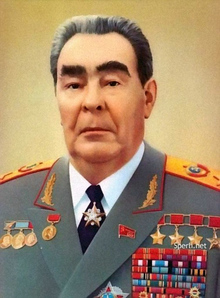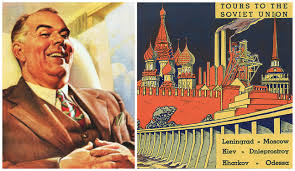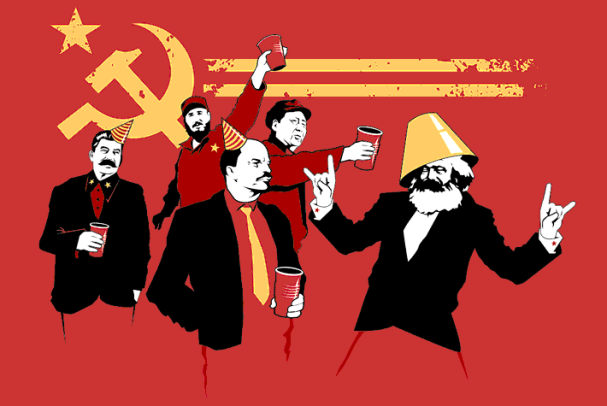
The 1970s in the Soviet Union is often referred to as the “era of stagnation“. The country had just seen the removal of Nikita Khrushchev from power in 1965 and Leonid Brezhnev soon became the General Secretary of the Soviet Union. The era started with significant economic growth in the industrial sector but was lacking in the areas of agriculture and consumer goods. A famine in 1975 continued to cripple the agricultural economy and forced Brezhnev to get grain from international sellers. The ever increasing defense spending in order to keep up with the United States during the Cold War eventually contributed to the deterioration of the Russian economy. A costly war in Afghanistan also further crippled the economy and eventually helped lead to the dissolution of the Soviet Union in 1991. On the other hand, Brezhnev tightened control on Soviet society and people, which was reminiscent of the Stalinist era. He made meetings in large groups illegal and cracked down on all political dissidents. One of the many reasons the era was known as one of “stagnation” was the age of the men in power in the Government. They were all Soviet hardliners who had been around during Stalin’s era and were unable and unwilling to recognize the need for political and social reform within their country, highlighted by Brezhnev’s claims of the “stability of the cadre”, exemplified by “the fact that nearly half of the Central Committee members in 1981 were holdovers from fifteen years earlier” (Countrystudies.us). Although Brezhnev tried his best to tighten Soviet control of the country, foreign culture still slipped through the cracks and thrived, whether that be cinema or rock and roll. These years saw the slowing down of and arrival of a static nature of the Russian economy, politics, and culture but it also had its highlights. One such positive of the era was the continuation of exchange programs, academic exchanges, and bilateral scientific endeavors, which enabled foreigners, especially Americans to come into the country and for Russians to travel and see other parts of the world outside the Eastern Bloc and expand their cultures beyond their own borders.

Beginning in the 1950s, even though the two countries were beginning the Cold War, both the United States and the Soviet Union started to try to figure out ways to open their countries to the other, politically, economically, and socially. Beginning with the the Lacy-Zaroubin Agreement in 1958, which provided for cultural exchanges between the two countries in the areas of agriculture, science, medicine, and film, the two nations periodically started to send their students, professionals, historians, and scientists to each other, if only to insert CIA and KGB agents into these exchange groups to spy on each other. These exchanges were also utilized by the Soviet Union to learn as much as they possibly could about science and technology from the United States and the United States also attempted to decipher the enigma that many Americans saw the USSR to be. One such example of these cultural exchanges can be seen through the eyes of Galina Koltypina, who worked at the Lenin Library in Moscow. In 1956, she was tasked with taking visiting Swedish librarians on a tour of libraries around Russia and the city of Krasnodar on the coast of the Black Sea. When she arrived in Krasnodar, however, it was soon clear that the city was not ready for foreign guests and the entire hotel had to be completely cleaned, repainted, and a lock was placed on the bathroom door so that only the Swedes were allowed to use it (Russia Reader). This story reflects the want of the Soviets to expand and learn, but at the same time not wanting to submit to the eventual corruption of their people to foreign influences. It is also a perfect example of one such cultural exchange that allowed foreigners to come into the country and explore it for the first time. Even though the country was opening its arms to foreigners, it was still extremely cautious and protective of what these foreigners were able to see and do during the Khrushchev era. These programs of social exchange vastly increased and were more relaxed during the reign of Brezhnev during the 1960s through the early 1980s, as opposed to the trip described by Galina Koltypina. Although the decade was one of “stagnation” these cultural exchange programs and bilateral academic pursuits expanded, opening the world up to the Soviet Union and the Soviet Union up to the world. During the 1970s, NASA and their Soviet counterparts to research physics and share technology with each other. Russian ballets began touring the United States and American literature flew into Russia through various academic endeavors to Russian libraries and universities. The Ministry of Culture in the USSR invited the Philadelphia Symphony Orchestra to come play all across Russia. As Russians spent more time in America and around Americans, the political dissent in the USSR grew louder and louder and these cultural and academic exchanges between the two countries contributed to the fall of the Soviet Union as a communist state.
Sources Used:
Rodionov, V. “Opponents of International Cultural Relations.” The Current Digest of the Russian Press 8.15 (1956): 27. EastView. Web. 18 Nov. 2015. <http://dlib.eastview.com.ezproxy.lib.vt.edu/browse/publication/6765?searchLink=/search/simple>.
http://envisioningtheamericandream.com/2014/03/25/travels-to-russia-2/
http://easyweb.easynet.co.uk/socappeal/russia/part6.html
http://www.nap.edu/read/10888/chapter/2
Barker, Adele, and Bruce Grant, eds. The Russia Reader, History, Culture, Politics. Durham: Duke UP, 2010. 633-638. Print.

This post sheds light on many important movements throughout the Soviet period. Brezhnev’s rule was known for its backwards-looking ways, which is part of the reason for later Soviet problems. Also, the exchange program is well-documented, but not widely discussed among non- Soviets. I think it was important for the Soviet citizens to “see the light” outside of their country, and learn about the many offerings around the world that were unavailable to them. Great post!
LikeLike
Really great post, you definitely put time and effort into researching the topic. You definitely helped shed some light on this era and i certainly feel like I understand it better. The way you describe the politburo at the time really helps draw the connections with their policies.
LikeLike
I never knew that both countries allowed these exchange programs while they were so closed off to each other at the same time. They must have known that there would be spying involved, but I wonder how much they did it for the educational value. Also, I wonder how the people were received in the other countries given the things that each country said about the other.
LikeLike
Oh wow. I really like how your analysis builds up to Koltypina’s article about the visit of the Swedish librarians. Her memoirs highlight how the authorities were both incredibly interested in and very concerned by foreigners. It’s that eagerness for interaction and exchange, on the one hand, and the determination to make a good impression, on the other, that made these encounters so memorable.
Also, great link to the ABT tour page! What a cool source. Did you check out the Current Digest as well?
If you’re interested in this topic, there’s a great book called The Dancer Defects, by David Caute….
LikeLike
I tried to use the Current Digest but no matter which keywords I used, 90% of the articles were about the money exchange rate between Russia and the U.S. I’ll have to check the book out!
LikeLike
I wonder what the motivation for allowing these exchange programs to happen was. It is hard to believe that the Soviet government would condone this type of exchange, especially in a period where they were trying to tighten control on the Soviet people. Whatever the motivation was, I think the cooperation between the two nations was a good thing and allowed at least a small amount of cooperation between them.
LikeLike